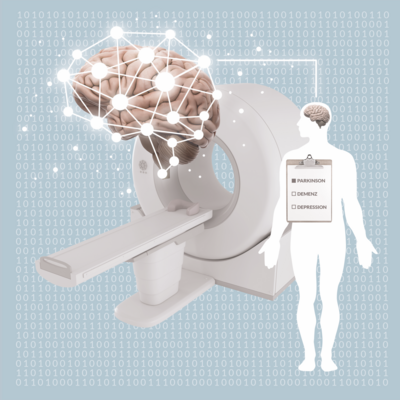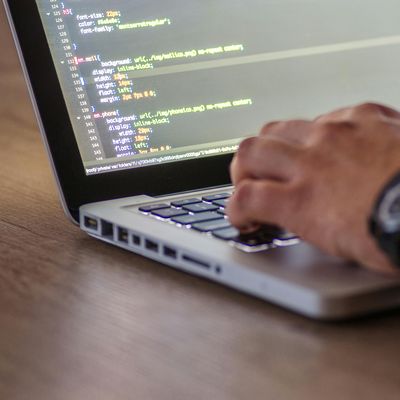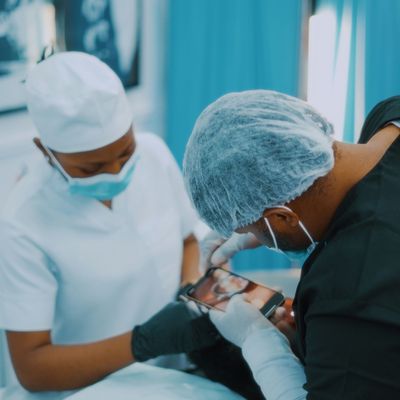Fighting cancer with artificial intelligence

How can diseased tumor tissue be destroyed in a targeted manner while preserving the healthy tissue immediately surrounding it? Alexandra Walter uses data science and artificial intelligence to make radiation therapy even more precise.
When people are diagnosed with cancer, they have to face a difficult fight that literally takes everything they’ve got — because radiation not only destroys tumor tissue, it always destroys a certain amount of healthy tissue as well. The only question is how much healthy tissue is subjected to radiation and how extensive the sacrifice is. Healthy tissue damaged by radiation often loses some of its function afterwards too. One of the most common side effects of radiation in the mouth and neck region is dryness of the mouth caused by the salivary glands being impaired. This can be very unpleasant for those affected.
Alexandra Walter is committed to keeping all these negative impacts of radiation to a minimum. For her doctoral thesis, the 26-year-old is working to pinpoint malignant tumors in the head and neck regions of cancer patients with enough precision for diseased tissue to be destroyed as completely as possible while at the same time leaving as much healthy tissue as possible untouched.
More diseased tissue could be destroyed, and more healthy tissue could be preserved.
Currently, doctors need to mark the tissue to be targeted by radiation on CT images prior to treatment. “This can take up to three hours if you don’t have any other tools. The algorithms already available to doctors use another patient’s data as the starting point,” says Walter. She notes that this approach does work to a certain extent, but only to a certain extent. Walter is convinced that it can be significantly improved upon. More diseased tissue could be destroyed, and more healthy tissue could be preserved. This would benefit many, many people, given that head and neck tumors are the fourth most common type of cancer, with more than 20,000 new cases in Germany every year.
In the first phase of her PhD at the Helmholtz Information and Data Science School for Health (HIDSS4Health), Walter is initially working to improve an existing, intelligent computer program that independently detects tumor tissue. The program then provides the doctor with an immediate suggestion as to where to direct the radiation. The program is referred to as an artificial neural network, a highly complex software system that uses extensive internal circuitry with a structure similar to that of the neural network in the human brain to learn independently, so to speak. Because of this, the system is also described as a type of artificial intelligence. “The program is, in a sense, trained, because it incorporates a wide range of data from completed courses of radiation therapy. I want to improve the program by adapting its structure and adding new ways of learning. The ultimate goal is to make it much more precise,” Walter explains. This would mean improved prognoses for patients, and subsequent impacts such as damage to the larynx and the associated speech impairment would become less common.
"I want to improve the program by adjusting its structure and adding new learning opportunities. Patients' prognosis improves, and sequelae become less frequent."
Alexandra Walter, doctoral researcher at HIDSS4Health
Walter’s approach consists of testing, combining, calculating, and programming; a mix of mathematics and computer science. This is the exact combination she learned while studying for her bachelor’s degree in cognitive science at the University of Tübingen. In addition to neurobiology, this field incorporates computer science and mathematics in particular. Walter followed this with a master’s degree that focused on the field of logic and wrote her thesis on the interpretability of neural networks. She is now able to conduct research at HIDSS4Health, which is part of the Helmholtz Information and Data Science Academy (HIDA), Germany’s largest postgraduate training network in information and data science. Walter enjoys this not only because she can apply many of the things she has been focusing on over the past few years. “I love how interdisciplinary it is here. Even though it has become something of a buzzword, the interplay between multiple disciplines is in fact an everyday reality in my PhD,” Walter says.
What is cancer, how does it occur and why is it so difficult to treat?
Even before she moved to Karlsruhe about six months ago to start her doctorate at HIDSS4Health, she bought and worked her way through a number of medical textbooks. “Medicine is the component I addressed least during my degree. So that was where I needed to invest most energy in the beginning,” Walter says. She is now familiar with the anatomy of the head and neck and understands what cancer is, how it occurs, and why it’s so difficult to treat.
This knowledge was then quickly reinforced at HIDSS4Health by a combination of practical experience, opportunities to exchange ideas, and explanation. One key factor was simply the research institutions involved in the program — the Karlsruhe Institute of Technology (KIT), Heidelberg University, and the German Cancer Research Center (DKFZ). Like these institutions, HIDSS4Health is also based in Heidelberg and Karlsruhe.
All doctoral researchers on the program, including Walter, have two supervisors from two disciplines. In her case, one is from the field of health science at DKFZ, and one is from data science at KIT. And then there are the lectures, workshops, seminars, and summer schools. “Most of these events bridge the gap between health science and data science. Given my background, my starting point is the data science side of things, and my colleagues with medical backgrounds contribute to my work with their knowledge of health science,” explains Walter.
The researchers come together, discuss their work and are creating new knowledge in the process
Knowledge is the key currency in an environment like this, where experts from different areas work together and learn from each other. Everyone knows something different and the researchers come together, support each other, exchange ideas and experiences, and discuss their work, creating new knowledge in the process. Walter thinks it’s particularly useful to have everyone look at the same problem from different perspectives. In many cases, each new point of view yields new insights, too. “If I look at neural networks through the lens of computer science, for example, they are essentially tools. If I look at them from the perspective of mathematics, they are mathematical functions. And if I combine the two, I can better understand these tools and improve them. It might sound strange, but this sort of thing makes me really happy,” Walter smiles.
Walter’s résumé would suggest that she’s been working towards her doctoral post at HIDSS4Health for years. But that wasn’t the case. “I didn’t have a specific goal. I just always went in whatever direction I found interesting,” Walter says. It was only when she wrote her application for the doctoral post at the Graduate School that she realized she would fit in really well there! The path that Walter has taken is a perfect example of how a certain amount of inexperience and open-mindedness can sometimes be the right approach. Do what interests you and success will follow on its own. “It’s worked for me so far, and I’m thankful for that,” she says.
Walter’s thesis can truly benefit patients, and this also motivates her. “I’ve made a few visits to the centers where patients go for radiation. The fact that my work can help to prolong their lives and improve their chances of recovery makes everything I do even more important, and I also feel a certain sense of responsibility.”
"The program will never be able to replace doctors. But ideally, it will be able to determine where the radiation should be focused, so the doctor will only have to approve it or, at most, make small adjustments."
Alexandra Walter, doctoral researcher at HIDSS4Health
As a neural network, the program learns with each correction
Walter will also need motivation and a sense of responsibility for what lies ahead over the next two and a half years. After the first phase of her PhD, which involves improving the current assistance program used for radiation therapy, Walter will try to integrate doctors’ knowledge and experience into the neural network. Among other things, this will include practical knowledge and existing guidelines for radiotherapists. “The program will never be able to replace doctors. But ideally, it will be able to determine where the radiation should be focused, so the doctor will only have to approve it or, at most, make small adjustments,” says Walter.
Once the program is completed, the third phase will focus on optimizing it. “As a neural network, the program essentially learns from every correction a doctor makes to it. But, of course, I want to get everything done before it’s applied in clinical practice in order to ensure a high level of precision from the start,” Walter explains. During the process, the focus is always on two, closely interlinked aspects: Where should the radiation be directed to specifically destroy bad, diseased tissue, and what should it avoid where possible to preserve good, healthy tissue in a targeted manner. This is Walter’s mission.
Author: Christian Heinrich










